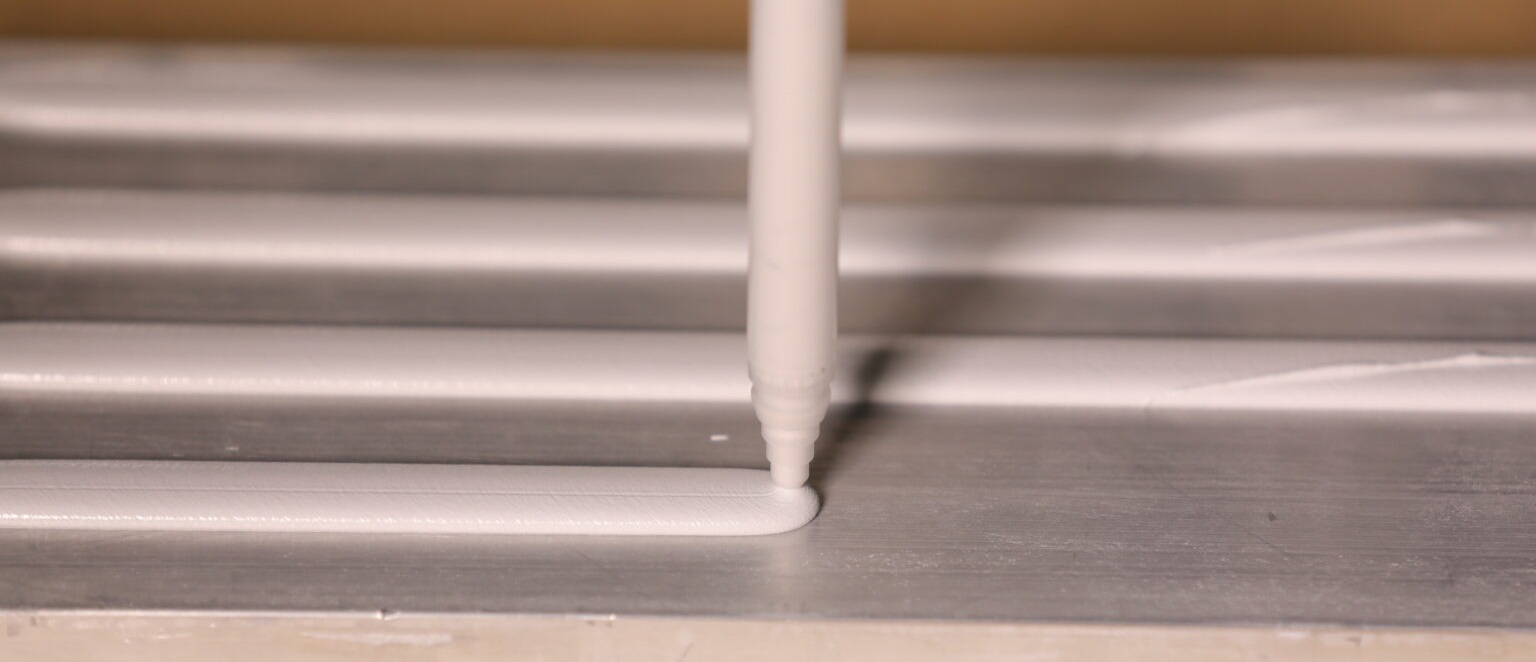
Header image courtesy of Parker
In EV battery manufacturing, adhesives are increasingly used to bond components. They are replacing mechanical fasteners as well various joining technologies. Unlike screws, bolts, and welding, structural adhesives provide a range of benefits beyond the bond.
The list of benefits is impressive:
- Structural adhesives reduce the EV’s weight and hence improve its range.
- They are easier to automate than alternatives.
- They can be used for sealing, thermal transfer, and structural integrity.
- They can bond dissimilar materials.
- They offer more design flexibility.
In this article, we explore the important role that adhesives play in electric vehicle battery manufacturing.
Table of Contents
- Adhesive Applications in Battery Modules
- Where Adhesives Are Used in Battery Modules
- Types of Adhesive Chemistries
- Surface Preparation to Improve the Bond Strength
Adhesive Applications in Battery Modules
Thermally Conductive Adhesives
Thermal adhesives are used to both join battery components and conduct heat away from heat-generating components. They are part of a battery’s thermal management solution to control the battery’s temperature and, as a result, improve its range, performance, longevity, and safety.
Thermal adhesives contribute to heat dissipation and thermal performance by creating efficient thermal connections between components. They ensure uniform contact and optimal heat transfer.
The heat extracted using adhesive originates from electrical resistance in the battery’s electrodes, electrolyte, current collectors, busbars, and various interconnections. For this reason, thermal adhesives are used at several locations in battery modules, such as between individual cells, or between cells and cooling plates.
Structural Adhesives
Structural adhesives are used in EV battery packs to create bonds that can withstand various environmental conditions and mechanical loads. These adhesives provide shear and tensile strength to increase protection against external forces such as impacts, vibrations, and loads.
With structural adhesives, battery components are stronger together. One such example is the structural battery pack, where batteries become part of the load-bearing structure.
The choice of structural adhesive depends on where it is used. Different adhesives provide different levels of strength and flexibility. The material’s compatibility with the adhesive is also a key factor.
Gasketing & Sealing
EV batteries need to be sealed tight to withstand various environmental factors. Humidity, for example, is a common cause of failure in EV batteries.
Adhesives play a key role in sealing various battery components. Mechanical fasteners (gaskets) are used with liquid sealants to create tight seals between battery components, safeguarding against moisture, contaminants, and other factors. They prevent water, dust, and corrosive elements from compromising the internal components of the battery module.
Where Adhesives Are Used in Battery Modules
Adhesives are used at several locations in battery modules to help dissipate heat, insulate electrical components, seal off against environmental damage, and create strong structural bonds.
Here are common examples of where they are used:
- Cell casings: Adhesives between battery cells help maintain a good thermal contact between individual cells, allowing the heat generated during operation to spread evenly. They can also provide a strong and durable bond to distribute the stress load uniformly and improve the vehicle’s structural integrity.
- Cooling plates: Adhesives between battery modules and cooling plates facilitate heat transfer to dissipate heat. Newer cell-to-pack designs bond individual cells directly to the cooling plate.
- Enclosures and housings: Adhesives contribute to the robustness of enclosures and housings, providing secure bonds that withstand mechanical stresses and environmental conditions.
- Small components: Adhesives are used to attach small components such as heat spreaders, thermal pads, and sensors. Depending on the attached components, adhesives can provide various benefits, such as better thermal conductivity or insulation.
Types of Adhesive Chemistries
Battery adhesives come under various forms, such as liquids, pastes, gels, tapes, and pads. The distinct types of adhesives offer different benefits:
- Acrylic-based adhesives are known for their ability to bond a broad range of raw metals, composites, and thermoplastics. Available at various viscosities, they are easy to dispense and show non-sag characteristics. A long-lasting bond can be achieved quite fast, sometimes under 5 minutes if necessary. These characteristics allow fast cycle times, for example as needed in cell bonding.
- Epoxy-based adhesives are known for their strength and good chemical resistance. They are used when structural-grade bonds are needed alongside thermal performance. They enhance the structural integrity of components within the battery module.
- Urethane-based adhesives are known for their durability, elasticity, and low odor compared to other chemistries. They are used in applications where high dynamic loads are required for impact resistance. Offering thermal conductivity, they have an optimal use case when it comes to battery pack manufacturing.
- Silicone-based adhesives are known for their elasticity, offering an alternative to more rigid bonding materials. They can accommodate thermal expansion and are particularly useful for sealing and insulating against environmental factors.
You can learn more about the types of adhesives here.
Surface Preparation to Improve the Bond Strength
Adhesives require careful surface preparation to ensure a high-quality, strong bond. Laser surface preparation is the best solution to prepare surfaces for adhesive bonding.
Lasers offer the following benefits:
- Improve the bond strength by (1) removing all contaminants, (2) creating the optimal surface texture, and (3) modifying the chemical composition of the surface.
- Meet the fast-paced requirements of EV battery production lines.
- Offer high repeatability.
- Minimize the variety of adhesives.
- Align with green goals.
Get the Best of Two Worlds
Adhesives that have high strength usually have less flexibility. By improving the bond strength with laser surface preparation, it becomes possible to use adhesives that are low-strength high-flexibility.
For battery module manufacturers, this offers the possibility to get the best of two worlds: strength and flexibility. Laserax has experience preparing various battery components for adhesive bonding. Examples include housings, cells, and cooling plates.
If you need help optimizing your adhesive bonding process, contact us today. We can help you achieve the perfect balance between the strength required for structural integrity and the flexibility needed to withstand dynamic stresses.
